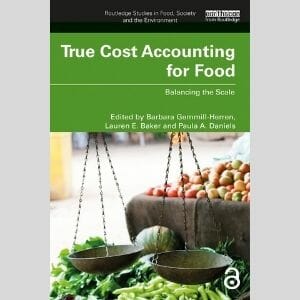
By Mauricio Bellon, Research Professor
One of the great achievements of the last century has been substantial increases in the supply of food with concomitant reductions in its price. This achievement has been associated with major changes in our food systems, particularly with the development of industrialized agriculture, changes in dietary patterns and increased availability of cheaper foods. However, we as consumers, producers and society in general are beginning to realize that these achievements can be costlier that we may have thought, in many different ways.
As my late grandmother used to say in Spanish “lo barato cuesta caro” (cheap is expensive) and that is certainly true of much of our cheap food today around the world. But how costly is food? How do we measure these costs? How can we use this information to make better decisions about our food systems? These are some of the topics addressed by the recently published book “True Cost Accounting for Food:-Balancing the Scale.” Obviously, addressing these issues is complex and multi-faceted. Thus this book brings together an impressive array of experts in different aspects of our food systems that provide multiple perspectives, but all grounded in a unifying framework called True Cost Accounting (TCA).
TCA recognizes that just looking at yields, profits, calories or proteins to judge the success and appropriateness of our food systems is misleading and generates widespread unintended consequences and costs, such as costs to equity, human health and the environment. These costs remain hidden when we make decisions of what food to eat, purchase, support and subsidize, and how we structure the institutional settings and associated regulatory frameworks in which these decisions take place, leading in turn to negative consequences for us and society at large. At the same time, many of the benefits that alternative production and food systems generate, such as those provided by smallholder farmers using low inputs or organic agriculture, are not recognized, encouraging the perceptions that these systems are backward or inferior and contribute little to feed the world.
To correct these unintended consequences and take into account the hidden costs and benefits of different components of our food systems, TCA recognizes four types of capital: natural, produced, social and human, that have to become visible, measured, and if possible monetized, if we want to improve our food systems. The different chapters in this book provide conceptual and methodological tools as well as a rich array of case studies that illustrate the applications of the approach. The book is divided into six sections, each one with several chapters addressing a theme. The sections/themes are: “The power and potential of TCA,” “Thinking systemically,” “From the field,” “For the public good,” “Through the value chain,” and “To the table.”
Several chapters provide examples from the real world in very different settings. For example, dealing with the true costs of dinning out, fostering healthy soils in California, transforming the maize treadmill, the real cost of unhealthy diets, or embedding TCA within the US regulatory decision-making. I particularly enjoyed the foreword by Guillermo Castilleja on why true cost accounting is important, and the insights of Kathleen Merrigan which argues that TCA should be seen as an evolution of cost-benefit analysis, a tool well-accepted and widely used by governments. This should help to enhance its adoption.
In the end, we need to make better decisions about the food we eat as consumers, producers, investors and policy-makers, and this book makes an important contribution to how to follow in this path.
True Cost Accounting for Food: Balancing the Scale, edited by Barbara Gemmill-Herren, Lauren E. Baker and Paula A. Daniels. 2021. New York: Routledge.
Open access is available here.